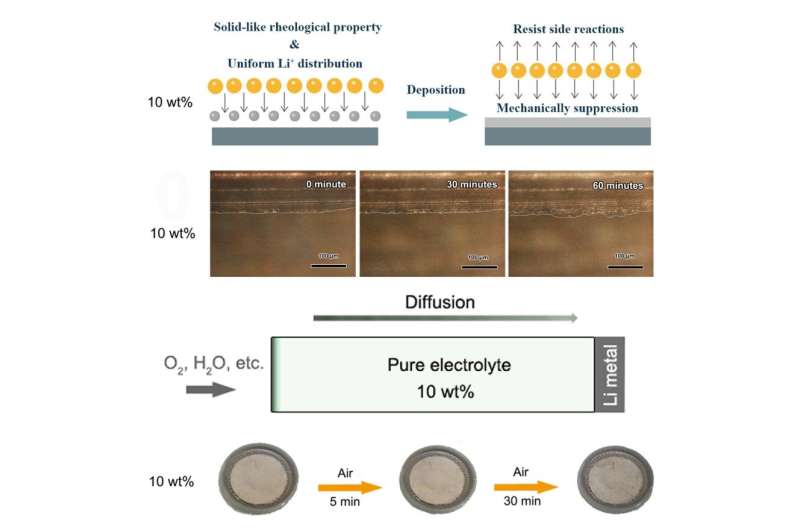Hydrophobic silica colloid electrolyte holds promise for safer lithium-oxygen batteries

Traditional lithium-ion (Li-ion) batteries cannot satisfy increasing demand for large-scale electricity consumption. Rechargeable aprotic lithium-oxygen (Li-O2) batteries have become potential candidates due to their ultrahigh theoretical energy density, which is about 10 times that of Li-ion batteries. Lithium metal as an anode is one of the key factors in obtaining such high specific capacity.
However, the use of a lithium metal anode inevitably triggers serious safety issues because the dendrite growth of lithium will pierce the separator and give rise to a short-circuit fire. Furthermore, the semi-open nature as well as the oxidizing environment of Li-O2 batteries will cause more severe parasitic side reactions, thus hindering development of Li-O2 batteries. Therefore, it is vital to figure out how to effectively protect the lithium metal anode of Li-O2 batteries.
Recently, a research team led by Zhang Xinbo from the Changchun Institute of Applied Chemistry (CIAC) of the Chinese Academy of Sciences developed an electrolyte regulation strategy by in situ coupling of CF3SO3- on hydrophobic silica colloidal particles via electrostatic interactions in order to prevent lithium dendrite growth and corrosion. These findings were published in Matter on August 28.
The researchers found that this strategy could couple the anion with nanosilica via electrostatic interaction thus avoiding the formation of a strong electrical field during the lithium deposition process.
A hydrophobic silica colloid electrolyte (HSCE) with a low diffusion coefficient of 10 wt% along with the hydrophobic property of silica led to a 980-times better anticorrosion effect, thus greatly reducing lithium corrosion in Li-O2 batteries. Moreover, by using 10 wt% HSCE, stable and long-life electrochemical performance was obtained in these batteries.
"We believe this comprehensive and effective protection strategy can spark more inspiration in electrolyte regulation methods, thus achieving better electrochemical performance," said Zhang.
This study also provides an effective electrolyte regulation strategy to solve the dendrite and corrosion issues in alkali-O2 batteries and alkali-air batteries. These batteries have the potential for good electrochemical performance in practical applications, and will help release the great potential of alkali metal anodes.
More information: Yue Yu et al. In Situ Coupling of Colloidal Silica and Li Salt Anion toward Stable Li Anode for Long-Cycle-Life Li-O2 Batteries, Matter (2019). DOI: 10.1016/j.matt.2019.06.002
Provided by Chinese Academy of Sciences





















